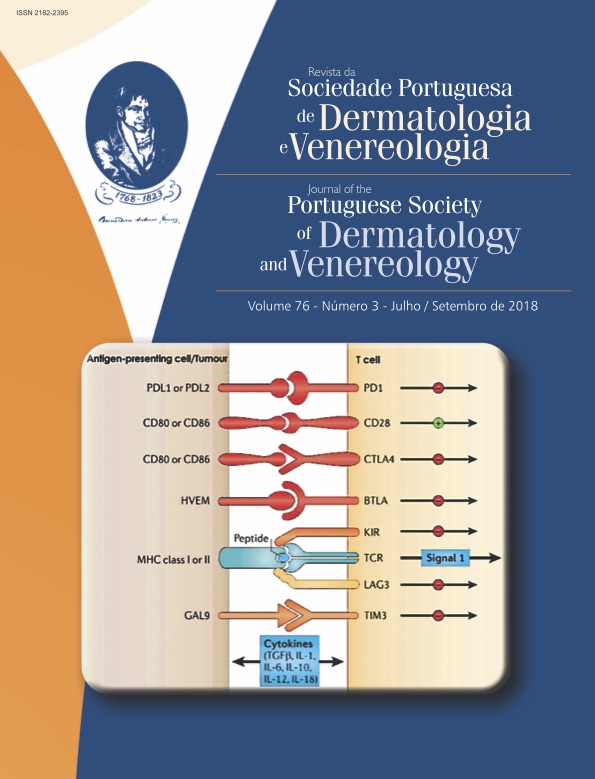Projecto Angolano de Formação e Desenvolvimento da Dermatologia: Avanços e Desafios
Resumo
Introdução: Apesar do fardo e das repercussões físicas, psicológicas e sociais que as doenças da pele representam, o desenvolvimento da Dermatologia e a formação de técnicos nessa disciplina defrontam em Angola sérios desafios, com repercussões no acesso e na qualidade dos serviços e cuidados prestados a população.
Metodologia: Foi realizado um estudo retrospectivo do Projecto de Formação e Desenvolvimento da Dermatologia, iniciado em 2010 com o apoio do Ministério da Saúde e do Colégio Angolano de Dermatologia e Venereologia (CADV). O projecto tem por objectivo a formação de mais dermatologistas e de aumentar o acesso dos doentes a Serviços de referência. São apresentados dados sobre a formação dos internos, bem como outros ganhos e limitações do Projecto.
Resultados: Até 2013, o internato médico complementar em Dermatologia estava reservado apenas a um Serviço de Dermatologia em Luanda, tendo formado oito dermatologistas desde 1975. Em 2013, cinco novos Serviços Regionais, abertos em Cabinda, Malange, Huambo, Benguela e Huíla, iniciaram a formação de especialistas, aumentando em 2017 a 26 o número total de internos em formação.
Conclusão: No contexto de Angola, a descentralização dos serviços clínicos de formação, a afinação periódica do programa de pós-graduação e a promoção activa de atitudes e actividades de pesquisa são elementos chave no desenvolvimento da Dermatologia e na prestação de serviços de referência mais próximos das populações.
Downloads
Referências
Gomes TM, Miranda Soares de Moura A T, Cavalcanti
de Aguiar A. Dermatologia na Atenção Primária: um
Desafio para a Formação e Prática Médica. Rev Brasil
Edu Méd. 2012; 36: 125-8.
Pitché P, Tchangai-Walla K. La dermatologie en Afrique
Noire, quelles perspectives pour le 21e siècle ? Nouv
Dermatol. 2000; 19: 44-8.
Pereira A. O. Contribuição ao estudo do perfil nosológico
das consultas ambulatórias nos centros de saúde em
Luanda. Luanda: Faculdade de Medicina da Universidade
Agostinho Neto; 2009.
Fortes F. Doenças Tropicais Negligenciadas em Angola e
a Dermatologia. Comunicação no 1º simpósio nacional
de Dermatologia, Luanda, 2015.
Hay R, Estrada R, Grossmann H. Managing skin disease
in resource-poor environments – the role of community-
-oriented training and control programs. Int J Dermatol.
; 50: 558–63.
Nkabinde TC, Ross A, Reid S, Nkwanyana NM. Internship
training adequately prepares South African medical
graduates for community service - with exceptions.
S Afr Med J. 2013; 103:930-4.
Lowell BA, Froehlich CW, Federman DG, Kirsner RS.
Dermatology in primary care: Prevalence and patient
disposition. J Am Acad Dermatol. 2001; 45:250-5.
Beltraminelli H. 2018 Africa. Where do we stand in Dermatopathology
training? Oral communication, 4th African
Dermatology Conference, RDTC Moshi, 2018.
Völker K. Tropenmedizinisch/tropendermatologische
Ausbildung in Tansania und Ghana. Ein Erfahrungsbericht.
Hautarzt. 2015; 66:311 – 319
Regional Dermartology Training Centre [consultado
01.2018] Disponível em:http://rdtc.go.tz/index.html
XLIV Congresso Brasileiro de Dermatologia- Simpósio
sobre Pós-graduação em Dermatologia. An Bras Dermatol.
; 65
Ferreira A V, Fresta M, Simões CF, Do Rosário SM. Desafios
da educação médica e da investigação em saúde
no contexto de Angola. Rev Edu Méd Brasil. 2004; 38:
-41.
Ordem dos Médicos de Angola. Regulamento Geral do
Colégio De Dermatologia e Venereologia de Angola
CADV. Luanda: OMA; 2010.
Projecto de Desenvolvimento da Dermatologia a Nível
Nacional. Luanda: MINSA; 2010.
Voumard A.L. Estudo comparativo da formação pré e
pós-graduada em Dermatologia no Pequim First University
Hospital e na FMUAN. 2004.
Decreto Presidencial No 17/04 de 31 de Maio sobre o
internato complementar médico. Diário da República,
Luanda 2004.
Decreto Presidencial No 260/10 de 19 de Novembro
sobre o Regime Jurídico da Gestão Hospitalar. Diário da
República, Luanda 2010.
Decreto Presidencial No 271/11 de 26 de Outubro
sobre o internato complementar médico. Diário da República,
Luanda 2011.
Proposta de Regulamento geral do Interno de Especialidade
no Hospital Américo Boavida, Conselho Directivo
do HAB, Deliberação No 10/CD/HAB/2015.
Proposta de critérios para o reconhecimento da idoneidade
dos hospitais e serviços para realização de internatos
de especialidades. Luanda: MINSA; 2017.
Projecto de Dermatologia: Relatório do 1º Fórum sobre
o Regulamento e Organização dos Serviços de formação
em Dermato-Venereologia em Angola. Luanda:
MINSA; 2013.
Projecto de Dermatologia: Relatório sobre o Acto Central
de Abertura Oficial dos Serviços Regionais de Dermatologia.
Luanda: MINSA; 2013.
Projecto de Dermatologia: Programa do 1º Simpósio
Nacional de Dermatologia e Venereologia, Luanda,
Abril 2015.
Burgin S, Homayounfar G, Newman LR, Sullivan A. Instruction
in teaching and teaching opportunities for residents
in US dermatology programs: results of a national
survey. J Am Acad Dermatol. 2017; 76: 703-6.
Plee J, Barbe C, Richard M-A, Dréno B, Bernard P. Etat
des lieux de la formation des internes en DES de Dermato-
Vénéréologie en France (2005-2010). Ann Dermatol
Vénéréol. 2013; 140: 259-65.
AlGhamadi KM. Current status of Dermatology residency
training in Saudi Arabia: trainee’s perspective. East
Mediterr Health J. 2008; 14: 1185-91.
Alencar Marques S, Amante Miot H, Fernandes Abbade
LP. Produção científica publicada nos Anais Brasileiros
de Dermatologia (2003-2007). An Bras Dermatol.
; 83:555-600.
Figueiredo A. Dermatologia do seculo XXI: que desafios?
Que oportunidades? Comunicação no 1º simpósio
nacional de Dermatologia, Luanda, 2015.
Todos os artigos desta revista são de acesso aberto sob a licença internacional Creative Commons Attribution-NonCommercial 4.0 (CC BY-NC 4.0).








